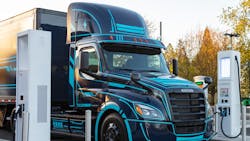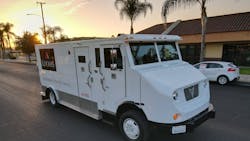City delivery is the ideal application for fleets to begin making the migration to battery-electric vehicles (BEVs). Shorter routes and slower speeds are among the many reasons why.
Steve Ivsan, head of program management at Xos, a BEV manufacturer founded in 2016, said that when a fleet considers purchasing a BEV, it should not look at it as just purchasing a vehicle. The fleet also is purchasing the necessary support that goes with that vehicle, along with the opportunity to reduce operating costs.
“Especially with the price of fuel right now, it’s fairly apparent that one of the major BEV cost-of-ownership benefits is fuel,” Ivsan said. “But maintenance is arguably even more impactful when you move to an electric powertrain.”
“There are far fewer parts and systems to maintain on an all-electric van and less service required overall,” said Andrew Walker, Ford Pro commercial van brand manager. “For example, you don’t need to perform a lube/oil filter change or a transmission flush on an E-Transit.” And since there are fewer mechanical parts, there’s a lot less lubricating that has to take place on a regular basis.
See also: Fleets and their customers are driving decarbonization
Ivsan said brake life could also be extended on a BEV, which benefit from regenerative braking. An electric motor helps decelerate the vehicle by providing drag when the brakes are applied, or the driver’s foot is taken off the accelerator pedal. That drag helps produce electricity, which helps charge the batteries. The other benefit is that the drag helps alleviate some of the work required of the braking system, resulting in less wear and tear on the friction brakes.BEV maintenance is still required
Despite all of the benefits of BEVs, brakes still need to be inspected regularly and serviced at the proper time. Furthermore, there are other key maintenance processes that must be completed at regular intervals on an electric powertrain, often every 12 to 36 months.
“Those include air compressor oil and filter changes, low-voltage battery checks, high-voltage wiring checks, e-axle or drive motor lubrication, and cooling circuit flushing,” said Kevin Otzenberger, product marketing senior analyst for Daimler Truck North America, which makes Freightliner trucks.
“I have seen some OEM maintenance schedules that recommend 5,000-mile intervals consisting of tire rotation, tread depth measurements, and fluid levels,” said Terry Rivers, VP of maintenance and technical training for Cox Automotive Mobility Fleet Services. “The tools required can fit in the palm of your hand, and the standard repair time for this interval on some electric vehicles is one-fifth of an hour. The vast majority of shops, if not all of them, already have the tools to perform most maintenance intervals on most BEVs.”
See also: Working together on scaling EVs
According to Otzenberger, service centers that plan to work on electric vehicles will need at least one or two technicians trained in high voltage (HV) who are qualified to decommission vehicles, ensuring that other employees can safely work around the HV components.
“Freightliner service center HV battery specialists, or decommissioning technicians, are required to complete ‘HV Level 3’ training, which is a multi-day, in-person training course with hands-on vehicle experience,” Otzenberger pointed out.
Something new that fleet maintenance facilities will have to adapt to is the need for charging infrastructure. Vehicles will need to be charged to enable a technician to perform diagnostics as well as before being returned to the customer.
The establishment of charging infrastructure throughout the country is an ongoing process still in its early stages. In the meantime, Otzenberger said fleets will have to be self-reliant, installing charging stations on their properties for depot charging.
Fleets running multiple shifts in a day must carefully plan for fast-charging sessions of two to three hours using 100 to 150kW DC fast chargers. Additionally, fleets running multiple BEVs can look to a charger management system that automates the process of charging vehicles sequentially, rather than simultaneously, based on priority.
This article originally appeared in its entirety on Fleet Maintenance, FleetOwner's sister publication and part of the Endeavor Commercial Vehicle Group.
About the Author
Gregg Wartgow
Gregg Wartgow covers the trucking and maintenance industries for Endeavor Business Media's Commercial Vehicle Group, which includes Fleet Maintenance and FleetOwner.


